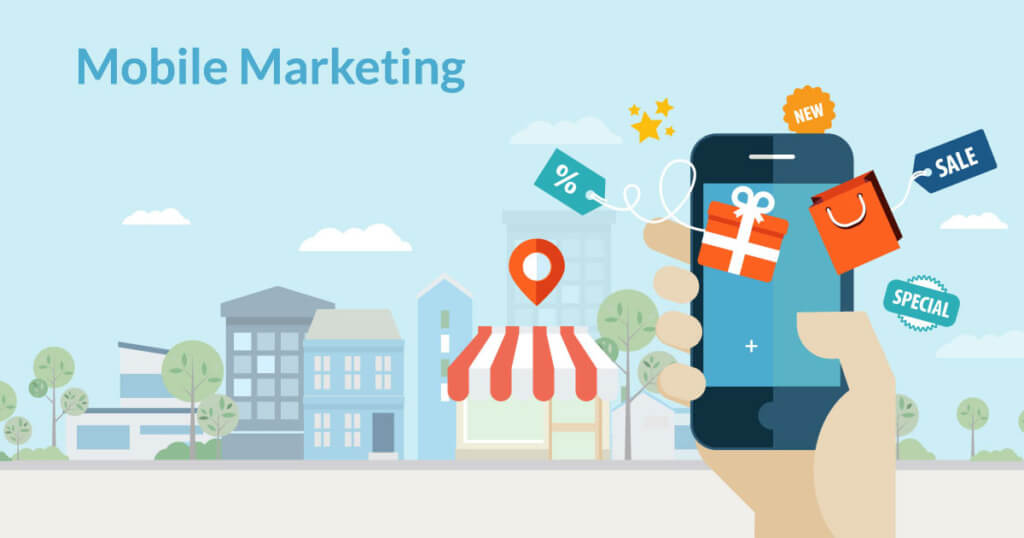If you want to expand your influence, increase your conversion rate, and grow your brand, you know that mobile marketing campaigns are an absolutely essential advertising strategy.
But what separates a successful mobile marketing plan from an unsuccessful one? And how can you ensure that you create mobile marketing campaigns that instantly engage with your customers — no matter what they’re doing on their phones?
In this post, we’ll tell you 10 of the most effective mobile marketing tips that you need to build your brand, connect with your customers, and generate serious profits.
Why Mobile Marketing Campaigns Matter

Before we get into our top ten tips, let’s talk about why mobile marketing campaigns are such a crucial part of your overall advertising strategy.
First of all, let’s take a look at some incredibly compelling statistics about mobile use.
Since the year 2012, mobile online searches have increased by over 200% every year. Additionally, about 40% of the overall time people spend on the Internet takes place on mobile browsers.
Further, about 80% of the time people spend on their mobile phone is dedicated to using apps.
Finally, if you don’t start embracing mobile marketing campaigns now, you’re going to be left in the dust. In fact, by the year 2019, it’s expected that mobile marketing will make up over 70% of a company’s total marketing spending.
Of course, these statistics aren’t the only things you need to convince you to start taking mobile ad campaigns seriously. There are a host of other benefits that mobile marketing campaigns offer. They include:
- Immediate customer contact
- Increased cost-efficiency
- Larger distribution opportunities
- A high responsiveness rate
- Shareability
- Quantifying/collecting data on campaign results
- Sending targeted messages to specific demographics
What Are The Different Types of Mobile Marketing Campaigns?
Next, let’s discuss a few of the many different types of mobile marketing campaigns.
Lots of brands mistakenly believe that there is only one way to do mobile marketing. That’s one way to guarantee that your competitors have an advantage over you.
Mobile campaigns can take on lots of different forms, including:
Text Messages
Text message mobile marketing campaigns can be personalized/customized to fit with the interests/needs of different segments of your target market. Often, these texts focus on specific products or alert customers about special offers.
Mobile Ads
These types of mobile marketing campaigns are centered around advertising space that your brand purchases on mobile sites.
Apps/In-App Purchases
Customers love the sleek look of company-specific apps. Plus, this often simplifies the buying process. An app is a condensed version of your website. You can also include the opportunity to make in-app purchases, to further your mobile revenue.
Social Media
You know from personal experience that so much of your social media use takes place on your smartphone or tablet. Ensure that campaigns using heavy amounts of social media promotion are mobile-friendly.
Mobile Searches
Unlike on the majority of desktop searches, searches conducted on mobile devices make it much easier for you to see your customers’ locations.
Mobile Email
It’s important that you ensure that any campaign emails you send out to potential customers can be easily read on mobile phones/tablets.
Mobile Websites
These mobile marketing campaigns take place on a version of your site that’s specifically mobile-friendly.
Often, this means smaller image sizes, a removal of auto-play/auto-download features, and more.
Our Top 10 Tips For Successful Mobile Marketing Campaigns
Now that you know a little bit more about why mobile marketing is so essential, and the many different channels you can use to boost your campaign, it’s time to get to our favorite mobile advertising tips.
1. Set Clear, Attainable Goals
Before you do anything else, the first step for any of your mobile marketing campaigns is to set specific goals — then plan out how you’ll achieve them.
 Additionally, these goals need to be in line with your current phase of business. For example, if you’re a startup that just opened shop a month ago, the goal of your first mobile campaign shouldn’t be “I want to acquire 100 new customers and make $250,000 in sales in two weeks.”
Additionally, these goals need to be in line with your current phase of business. For example, if you’re a startup that just opened shop a month ago, the goal of your first mobile campaign shouldn’t be “I want to acquire 100 new customers and make $250,000 in sales in two weeks.”
As much as we’d all love that, it’s just not a realistic goal (at least, not right now.)
Instead, get as specific as possible to avoid putting time, money, and energy into campaigns that will end up going nowhere.
Try something like, “I want to generate a lead list of at least 100 people, refine my target market, and learn more about how my customers behave online.”
Other common goals (again, depending on your current business phase) include:
- Providing customers with discounts to build brand loyalty
- Promoting a specific product/offer
- Closing more sales
- Gaining more social media followers
- Increasing app downloads
- Get more email subscribers
2. Create Content That Meets Your Target Customers Where They Are
Likely the biggest key to creating successful mobile marketing campaigns is learning as much about your customers as possible.
Know if they spend more time on social media on their phones, or if they primarily use their phones to respond to email. Do they make purchases on their phones, and if so, do they prefer to make those purchases through an app or a mobile website?
What type of content do they find most engaging? A text-based post, or a series of product images? What time are they most likely to open their email or respond to a text message?
Study up on your customer to create content you know they’re the most likely to respond to. This will help to push them towards taking your desired action.
If you don’t yet know as much as you’d like to about your target market, it can help to draw up a “customer prototype” of your dream client.
This prototype should include information about your target customer’s salary, profession, personal life, hobbies, general lifestyle, and pain points. In other words, think about how your mobile app, website, or mobile offers will make this customer’s life better.
Will it save them time, money, or treat one of their pain points? If not, it’s time to refine the goals of your campaign.
3. Test for Bugs and Glitches
In the world of mobile marketing, perfection matters.
 Seemingly small errors can have a huge impact on your conversion rate, and turn customers off of your brand altogether.
Seemingly small errors can have a huge impact on your conversion rate, and turn customers off of your brand altogether.
If you’re creating an app, first of all, make sure that it’s markedly different from your mobile website. Does it offer one-click checkout? Does it have a chat feature? Allow customers to directly upload images to their social media pages?
Next, consider common glitches like a slow loading time. Additionally, ensure that your app doesn’t shut off/close without warning, which can often result in lost purchases.
Next, ensure that your app won’t slow down the other apps on a user’s phone, or drain precious battery life. Finally, make customer security a central focus of your app. Often times, they’ll store their payment information on your app or even your mobile website.
Make sure you’re doing everything possible to keep it safe.
4. Ask for Customer Feedback
Sure, your mobile marketing campaigns will provide you with valuable customer data.
But while that statistical data will be helpful to you in building future campaigns, it’s also crucial that you have a way to directly connect with your customers.
If you’re using SMS marketing, allow your customers to briefly text you a review, or simply rate their buying experience from 1-10 by texting you back a number. Include a customer survey they can complete on their commutes home in your mobile email.
Read and respond to customer reviews in the app store, and update your social media profiles with polls. Get active, stay responsive, and let your customers know their voices have been heard.
5. Focus on App Store Optimization (ASO)
You’ve heard of Search Engine Optimization (SEO) but what about App Store Optimization (ASO)?
When you write content for your website, you use keywords to help you rank higher in search engine results.
When you list your app in the app store, you need to do what you can to make sure it gets noticed and earns you more downloads. Select a single, branded visual element for your app icon that makes it easy for customers to remember. If possible, don’t use words in that app icon.
Keep in mind that users see only the first 25 letters of your app’s name — so get to the point. If possible, include keywords in your title and app description. Avoid special characters, which could lower your ASO ranking.
6. Keep Text Messages Short
If you’re using SMS advertising, it’s important to keep those text messages as short as possible. This is especially crucial as lots of carriers don’t allow texts over 160 characters.
Plus, the faster you’re able to get the point, the more likely you are to close the deal.
Keep it to text like:
“Want free shipping plus 25% off on your next order? Click here to take advantage of this one-day offer.”
And speaking of “Click Here…”
7. Focus on Landing Pages
 Landing pages, or the mobile site page your customer lands on when they click an embedded link in a text or email, are just as important for mobile users as they are for desktop users.
Landing pages, or the mobile site page your customer lands on when they click an embedded link in a text or email, are just as important for mobile users as they are for desktop users.
Make sure to keep the landing pages you direct your clients to relevant, bug-free, and quick loading.
For example, in the one-day offer referenced above, the “Click Here” should be linked to a specific product page, featuring items included in the sale. It shouldn’t link a client to an old blog post, or a page featuring full-priced items.
8. Use as Many In-Ad Engagement Options as Possible
You already know just how short your own attention span is when you use your phone — and your target market isn’t any different.
They don’t want to have to waste time clicking through multiple pages to get to what they want. So, ensure that your ads and apps allow your users to click as few buttons as possible.
Keep your ads interactive, easy to navigate, and simple to increase your click-through rates.
9. Embrace Testing and Tweaking
A mobile campaign doesn’t stop the moment you hit “send” or “upload.”
In fact, it’s only the beginning! Constantly examine the data you’re getting from users while your campaign is running, and make adjustments based on that data.
For example, if you realize that your main demographic is different than you thought, or if you’re especially popular in a certain region or during a certain part of the day, make changes accordingly.
Evolving and analyzing as you go will only strengthen your campaign.
10. Clinch Them with a Strong CTA
Your “Call To Action” is one of the most crucial aspects of your mobile marketing strategy, no matter if you’re sending a text message or purchasing mobile ad space.
Some of the most effective CTAs include discount codes/coupons, buy-one-get-one offers, and free rewards for signing up for a newsletter/email list.
Be clear about the specific action you want your customer to take, and communicate the value that’s in it for them if they do.
Need Help Developing And Implementing Your Mobile/Digital Marketing Strategy?
We hope the above ten tips help you to design the mobile marketing campaigns of your dreams.
However, the reality is that these campaigns are just a small part of your overall digital marketing strategy. You’ll still need to consider marketing to desktop users, online reputation management, and your digital marketing strategy.
Digital marketing is a dynamic field, and not keeping pace with the changes won’t just put you behind your competitors — it may even get you penalized by Google.
Don’t panic, we’re here to help.
Get in touch with us today to learn more about how we can help you to create and implement a cohesive digital marketing strategy.
Start with our free digital marketing review to identify what needs improvement and what’s working well for your brand. Together, we’ll build your mobile and web presence from there.
Owner and Chief Marketing Officer, Jason Hall, and his team specialize in creating brand awareness / traffic and lead generation / marketing funnel and conversion optimization, while utilizing the appropriate marketing channels available within your industry. With diverse clients throughout the world, Jason's team is well connected within many industries to assist with your marketing strategies. With no long term contracts and various levels of service, Jason's team will increase the quality of your online traffic, leads, and sales.
About the author...
Located in the heart of the Emerald Coast - Destin, FL, founder and Chief Marketing Officer, Jason Hall, and his team specialize in creating brand awareness / traffic and lead generation / marketing funnel and conversion optimization / and PR campaigns, while utilizing the appropriate marketing channels available within your industry.
With diverse clients throughout the world, Jason's team is well connected within many industries to assist with your marketing strategies. With no long term contracts and various levels of service, Jason's team will increase the quality of your online traffic, leads, and sales.










